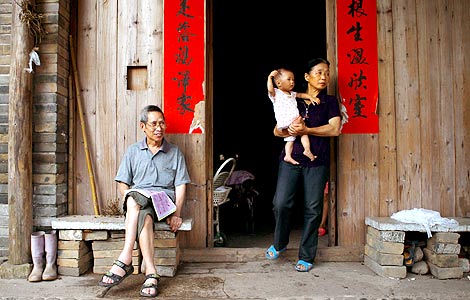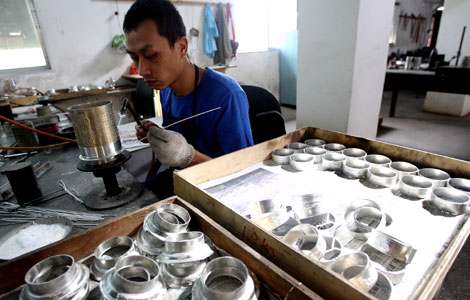Sidestepping the rush of modern life
Updated: 2013-09-05 07:54
By He Na and Hu Meidong (China Daily)
|
|||||||||||
Longevity
Like many villages in China's vast rural areas, Xiamei is chiefly populated by children, women and the elderly. Every morning after breakfast, people gather at the Bench of Beauty to chat, sing, listen to Peking opera and play chess or mahjong.
"Local people are still very honest and friendly and almost every family gate is open," said Zhang Shuang, a student from Shanghai. "When people discovered that we had entered their yards to take photos, they smiled and began chatting with us."
With such a clean environment and healthy lifestyle, Xiamei residents are long lived.
 |
|
Liu Qishu, 63, and his wife have been living in Xiamei for 40 years. Photo by Zou Hong / China Daily |
Zou Changcai, 82, still seems like a young man. He once met two visitors at the ancestral hall of the Zou family and sang folk songs because he was so happy to see them. To his surprise, they gave him 60 yuan out of gratitude.
Zou thought he had spotted a business opportunity and so every day he goes straight to the hall after finishing his farm work to wait for visitors. However, few people visit Xiamei now and business is poor. Zou remains cheerful, though, and will sing for himself if no one requests a song.
Liu Guiying, 79, has a comparatively prosperous life because both her children work for the local government, but she still sells handmade baby shoes in the village.
"I learned how to make baby shoes when I was young," she said. "If you want to live longer, you need to find some work for yourself."
Zhu Ezai, who selects tea for producers from May to August, earns 30 yuan for a 12-hour day, which helps to cover her living expenses.
"My children treat me very well, but I know they work very hard just to make ends meet. I can earn some pocket money by working and it's my way of exercising," she joked.
Protecting the past
The old houses in the village are listed as cultural relics, but few are habitable because they have been so poorly maintained. The need for new houses is increasing rapidly.
"To meet people's needs and protect the old buildings, we have already worked out a plan to build new houses for the villagers in a separate location in a few years," said Ye Sheng, the manager of a local tourism company.
But for most of the old people, the village is their home and they are happy to stay there.
In addition to Xiamei, several villages nearby also consist of ancient buildings, many of which have fallen into rack and ruin. In Chengcun village, most of the ancient wooden houses have been torn down and replaced by new structures.
Xiamei was hit by a flood in 2011 and many of the buildings still show signs of water damage. Luckily most of the old buildings survived and local officials and businesspeople have pledged to ensure that protection of these ancient architectural treasures is at the top of the agenda, said Ye.
Sun Li contributed to this story.
Related Stories
Tea farms wither amid heatwaves in E China 2013-08-10 11:43
Experts brew ideas for China tea 2013-05-27 02:16
Making of Wujiatai tea from C China 2013-03-26 16:25
Ground opens up in Guangdong village 2013-08-21 16:59
Photos: Yongguang village in Gansu province 2013-08-17 15:34
Today's Top News
Ex-railway deputy chief pleads guilty
Deal ensures supplies of natural gas
Campaign launched against child abuse
Auditor to monitor family planning fines
Xi, Putin meeting to focus on 'mega projects'
The white elephant in the room
China rejects building allegations
US divided over Syria attack
Hot Topics
Lunar probe , China growth forecasts, Emission rules get tougher, China seen through 'colored lens', International board,
Editor's Picks

|

|

|

|

|

|





